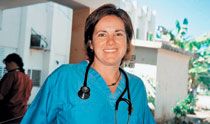Service in a strange land
You must watch what you eat. You can't drink the water or even brush your teeth with it. Nothing is sterile. And yet, my experiences at a spay and neuter clinic in the Dominican Republic have been among the most rewarding in my career.
Have you ever had the feeling you were right where you were always meant to be? I felt that way prepping for surgery in the rain outside of Los Cacaos, and I've since returned to the Dominican Republic three times in the last eight years.

Each trip with Project Samana, a volunteer program that runs temporary spay and neuter clinics in the Dominican Republic, has been an adventure. First, traveling to the Samana Peninsula is a long, tiring journey, and my most recent visit with Project Samana in November 2006 was no exception.
My son, Chatham, then 9 years old, and I left our home in Athol, Mass., at 3 a.m. It was nearly 6 p.m. that evening when we finally landed in the Dominican Republic, rented our car, and headed toward the country's northeast side.
The typically uneventful three-hour ride from Puerto Plata to Samana turned out quite the opposite. To start, there are few driving laws. The roads are winding, fast, rough, and filled with people, stray animals, and motorcycles. At one point in the dark, a bull charged across the road and we nearly hit it with our car.
But the most difficult part of the journey was traveling through Sanchez, the poorest destination we visited. The Dominican Republic was in political turmoil and preparing for an electricity strike. Angry citizens rioted and used burning tires, broken glass, rocks, and branches to block the only roadway. Although scared, we pushed through as people approached and threw rocks at our car. Luckily, the vehicle only suffered minor dents. You can imagine how happy we were to collapse at our final destination after a 19-hour journey.
The real work starts
The next day, our volunteer group traveled to downtown Samana to the government building we would occupy for our small animal work. Under the building's overhang, we arranged our canine and feline surgical area: a plastic preparation table, four surgery tables on cinder blocks, and a recovery area—newspapers on a dirty floor. The lack of electricity forced us to work by natural light, and we turned the surgery tables toward the sun.
For three-and-a-half days, we worked in 90-degree heat with flies for company. The locals came to observe our work, and we enjoyed trying to communicate with them and handing out the gifts and candy we brought from home. They're respectful and grateful for what we do, and they don't mind waiting for their animals to receive our care. When I burn out from the demands of veterinary care in the United States, they rejuvenate my faith in people and love for the work I do.
Bring on the horses
Our sizeable group of 15 allowed us to rotate care of the large animals. Alongside a beautiful beach, we dewormed, gave injections, and performed castrations. Our group also excised a mule's tumor, which the owner had removed with a machete twice before. Screwworms, large maggots that feed off live tissue, and chiggers, a mite found in the grass on these farms, were our main challenges. I was lucky enough to assist a horse castration—the first large animal experience of my career.
A little rest and relaxation
But it wasn't all work. We rode horseback through the village of El LÃmon to a beautiful waterfall. As an inexperienced rider, I was scared as my horse repeatedly slipped on the steep and rocky path, but the swim under the falls made up for it. We also distributed six suitcases of donated baseball supplies to some of the village's children, who were taken out of school for this special occasion. We even snuck in a game.
Our group spent the last evening in the resort town of Cabarete and unwound with good food, shopping, and fun in the sun and turf. Overall, it was another successful trip: We spayed or neutered 116 dogs and cats and performed about 30 large animal castrations.
For me, the trip's highlight was sharing the experience with my son. Chatham witnessed the social, political, and economic difference of a third-world country and gained a new appreciation for the things we take for granted, like electricity, a safe and constant supply of food and running water, and high-quality health care. I'm planning another trip with Project Samana this year, and Chatham wouldn't dream of letting me go without him.
Tracey Nowers, CVT, is the head veterinary nurse at Gardner Animal Care Center in Gardner, Mass. Please send questions or comments to firstline@advanstar.com

Tracey Nowers
Click here to view photos from Project Samana.